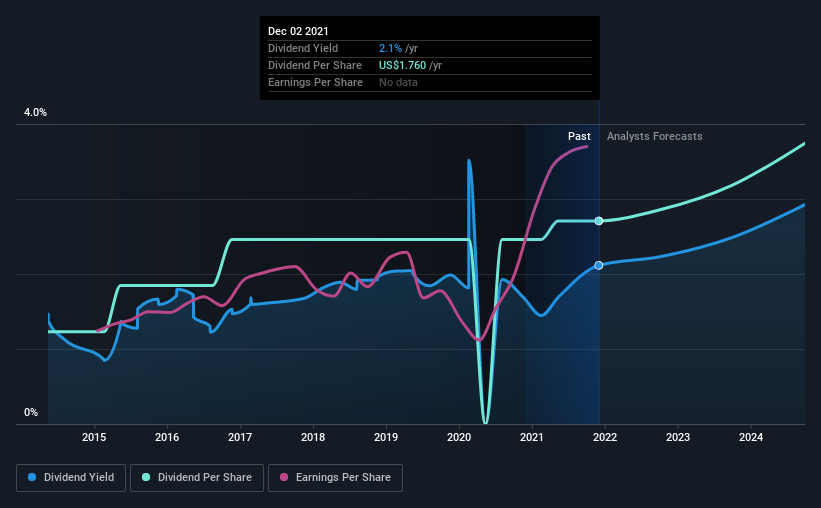There's A Lot To Like About Jack in the Box's (NASDAQ:JACK) Upcoming US$0.44 Dividend
Jack in the Box Inc. (NASDAQ:JACK) is about to trade ex-dividend in the next 4 days. Typically, the ex-dividend date is one business day before the record date which is the date on which a company determines the shareholders eligible to receive a dividend. The ex-dividend date is of consequence because whenever a stock is bought or sold, the trade takes at least two business day to settle. This means that investors who purchase Jack in the Box's shares on or after the 8th of December will not receive the dividend, which will be paid on the 23rd of December.
The company's next dividend payment will be US$0.44 per share. Last year, in total, the company distributed US$1.76 to shareholders. Based on the last year's worth of payments, Jack in the Box stock has a trailing yield of around 2.1% on the current share price of $83.21. We love seeing companies pay a dividend, but it's also important to be sure that laying the golden eggs isn't going to kill our golden goose! We need to see whether the dividend is covered by earnings and if it's growing.
See our latest analysis for Jack in the Box
Dividends are typically paid out of company income, so if a company pays out more than it earned, its dividend is usually at a higher risk of being cut. Jack in the Box is paying out just 23% of its profit after tax, which is comfortably low and leaves plenty of breathing room in the case of adverse events. Yet cash flows are even more important than profits for assessing a dividend, so we need to see if the company generated enough cash to pay its distribution. What's good is that dividends were well covered by free cash flow, with the company paying out 23% of its cash flow last year.
It's positive to see that Jack in the Box's dividend is covered by both profits and cash flow, since this is generally a sign that the dividend is sustainable, and a lower payout ratio usually suggests a greater margin of safety before the dividend gets cut.
Click here to see the company's payout ratio, plus analyst estimates of its future dividends.
Have Earnings And Dividends Been Growing?
Businesses with strong growth prospects usually make the best dividend payers, because it's easier to grow dividends when earnings per share are improving. If earnings fall far enough, the company could be forced to cut its dividend. It's encouraging to see Jack in the Box has grown its earnings rapidly, up 20% a year for the past five years. Jack in the Box earnings per share have been sprinting ahead like the Road Runner at a track and field day; scarcely stopping even for a cheeky "beep-beep". We also like that it is reinvesting most of its profits in its business.'
Many investors will assess a company's dividend performance by evaluating how much the dividend payments have changed over time. In the last eight years, Jack in the Box has lifted its dividend by approximately 10% a year on average. Both per-share earnings and dividends have both been growing rapidly in recent times, which is great to see.
Final Takeaway
Is Jack in the Box an attractive dividend stock, or better left on the shelf? It's great that Jack in the Box is growing earnings per share while simultaneously paying out a low percentage of both its earnings and cash flow. It's disappointing to see the dividend has been cut at least once in the past, but as things stand now, the low payout ratio suggests a conservative approach to dividends, which we like. Jack in the Box looks solid on this analysis overall, and we'd definitely consider investigating it more closely.
In light of that, while Jack in the Box has an appealing dividend, it's worth knowing the risks involved with this stock. For example, Jack in the Box has 4 warning signs (and 2 which are a bit unpleasant) we think you should know about.
We wouldn't recommend just buying the first dividend stock you see, though. Here's a list of interesting dividend stocks with a greater than 2% yield and an upcoming dividend.
Have feedback on this article? Concerned about the content? Get in touch with us directly. Alternatively, email editorial-team (at) simplywallst.com.
This article by Simply Wall St is general in nature. We provide commentary based on historical data and analyst forecasts only using an unbiased methodology and our articles are not intended to be financial advice. It does not constitute a recommendation to buy or sell any stock, and does not take account of your objectives, or your financial situation. We aim to bring you long-term focused analysis driven by fundamental data. Note that our analysis may not factor in the latest price-sensitive company announcements or qualitative material. Simply Wall St has no position in any stocks mentioned.

 Yahoo Movies
Yahoo Movies 

